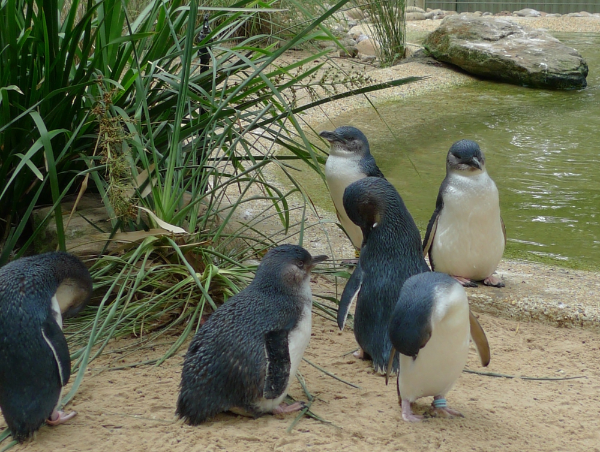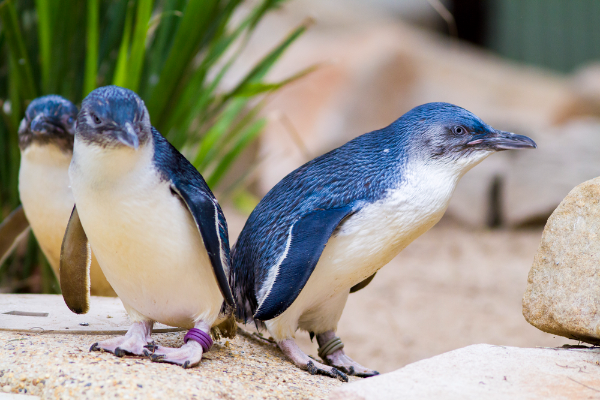Penguins are interesting creatures. They are flightless, but can swim up to speeds of 22 miles per hour. And did you know that penguins can hold their breath underwater for up to 20 minutes? In this blog post, we will be discussing the little penguin. Little penguins are the smallest species of penguin and they weigh in at an average of 2.2 pounds. Little penguins can be found on the coasts of Australia and New Zealand. While little penguins typically stay close to shore, they have been known to venture out into deeper waters. So what do little penguins eat? And how do they survive in such a harsh environment? Keep reading to find out!

Little Penguin Description
Little penguins are the smallest species of penguin in the world, with an average height of just over a foot. They are found on the coasts of Australia and New Zealand, where they live in burrows or nests made from rocks and seaweed. Little penguins are shy birds, and they are seldom seen far from shore. When they do venture out to sea, they dive deeply to catch fish and squid. Little penguins are black and white, with a distinctive band of blue feathers around their eyes. They have a life span of around 15 years in the wild. Little penguins are playful birds, and they often gather in groups to socialize. They mate for life, and parents take turns incubating their eggs and caring for their chicks. Little penguins are predators, and their main diet consists of small fish, squid, and crustaceans. Their predators include sharks, seals, and large birds such as gulls. Little penguins face many threats, including habitat loss and pollution. However, they are still relatively common, and their populations are stable. Little penguins are an iconic species of the southern hemisphere, and they are cherished by many people who live near them.
Little Penguin Habitat
Little Penguins are found on the coasts of southern Australia and New Zealand. They breed on offshore islands and mainland beaches with dense vegetation for shelter, finding burrows or hollow logs in which to nest. Little Penguins forage for food offshore, up to 60 km from their breeding colony, and return to the same site each year to breed. Although they spend most of their time at sea, Little Penguins come ashore to molt their feathers every year, usually remaining on land for around three weeks. Breeding takes place between May and August, with Little Penguin pairs forming lifelong bonds. One to three eggs are laid in a nest of vegetation inside a burrow or among rocks, and both parents share the incubation and care of the chicks. Little Penguins are Classified as Vulnerable by the IUCN Red List due to habitat loss and degradation, as well as predators such as stoats, cats and foxes. Control of these introduced predators is essential for the survival of Little Penguin populations.
Little Penguin Diet
Little Penguins are carnivores, feeding primarily on small fish and squid. Their diet can also include beach hoppers, krill, and other crustaceans. In some areas, they have been known to eat short-tailed shearwaters and Antarctic terns. Little Penguins typically hunt at night, using their sharp vision and hearing to locate prey. They will also dive to depths of up to 60 meters in search of food. Little Penguins typically eat around 300 grams of food each day. Due to their small size, they must eat frequently in order to maintain their energy levels.
Little Penguin Size
Little Penguins are the smallest species of penguin, and they are also one of the most diverse. They range in size from around 20 cm to 60 cm, and they can weigh anywhere from 500 g to 4 kg. Little Penguins are found in many different environments, from the cold waters of Antarctica to the warm beaches of Australia. They are also one of the longest-lived penguin species, with a lifespan of up to 20 years in captivity. Little Penguins are an important part of the marine ecosystem, and their small size makes them particularly vulnerable to predation and environmental change. As a result, Little Penguins are classified as “vulnerable” by the IUCN Red List of Threatened Species.
Little Penguin Lifespan
Little penguins are the smallest species of penguin, and they are found on the coasts of southern Australia and New Zealand. These pint-sized birds have a lifespan of about 6-8 years in the wild, though captive birds have been known to live for up to 20 years. Little penguins are monogamous, meaning that they mate with the same partner for life. However, if a mate dies, they will quickly find a new partner. Breeding season for little penguins begins in late spring, and pairs will build a nest together out of sticks and stones. Females will lay 2 eggs, which both parents will take turns incubating for about 35 days. Once the chicks hatch, they will be cared for by their parents for several weeks before fledging and striking out on their own. Little penguins face many threats in the wild, including predation by foxes and cats, habitat loss due to coastal development, and pollution from oil spills. As a result, their populations have declined in recent years. However, conservation efforts are underway to help protect these special birds.

Little Penguin Behavior
Little Penguins are the smallest of all penguin species, and they are found on the coasts of southern Australia and New Zealand. They are also sometimes called fairy penguins or blue penguins due to their small size and bluish feathers. Little penguins are social birds, and they often huddle together to keep warm. They typically lay two eggs at a time, and both parents help to incubate them. Once the chicks hatch, the parents take turns feeding them until they are old enough to fend for themselves. Little penguins are mostly active at night, and they often use their wings to “fly” underwater in search of food. Their primary predators are large birds of prey, such as owls and eagles, but they can also fall victim to feral cats and dogs. Consequently, Little Penguins must be constantly on the lookout for danger. Overall, Little Penguins are fascinating creatures with a variety of unique behaviors.
Little Penguin Speed
Little penguins are the smallest species of penguin, and they are also the fastest swimming penguin. They can reach speeds of up to 20 miles per hour when swimming underwater. Little penguins are also excellent climbers, and they are known to climb rocks and cliffs to reach their nesting grounds. Their small size and agility help them to evade predators, and their dense plumage helps to keep them warm in the cold water. Little penguins are an essential part of the ecosystem, and they play a vital role in the food chain. Unfortunately, their populations have declined in recent years due to predators, pollution, and climate change.
Little Penguin Hunting
Little Penguin hunting is an increasingly popular sport in Australia. Little Penguins are small, native birds that are found in coastal areas. They are an easy target for hunters, as they generally reside in open areas and are not very shy. Hunting Little Penguins is a relatively simple process; the bird is flushed out of its burrow by a dog, and then shot with a shotgun. Little Penguin hunting is often seen as controversial, as the birds are considered to be a protected species. However, many people argue that the sport helps to control the Little Penguin population and helps to preserve the natural balance of the ecosystem.
Conclusion
We hope you enjoyed this introduction to Little Penguin. Our team is excited to continue developing and expanding this product for our customers. If you have any questions or suggestions, please don’t hesitate to reach out to us. Thank you for your continued support!
Frequently Asked Question

